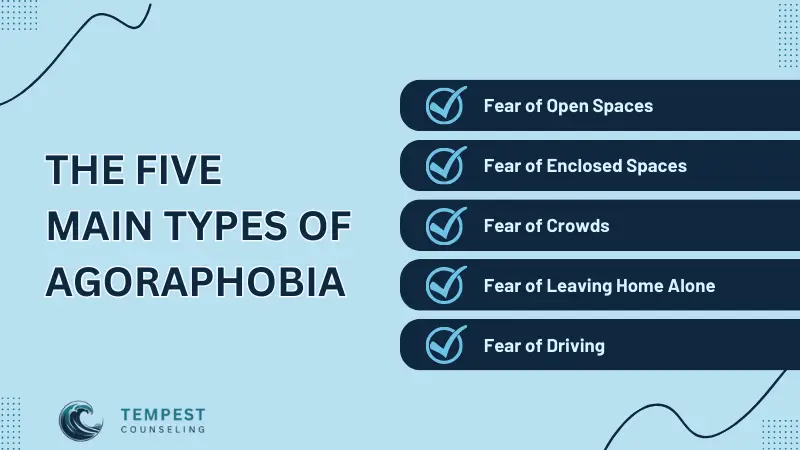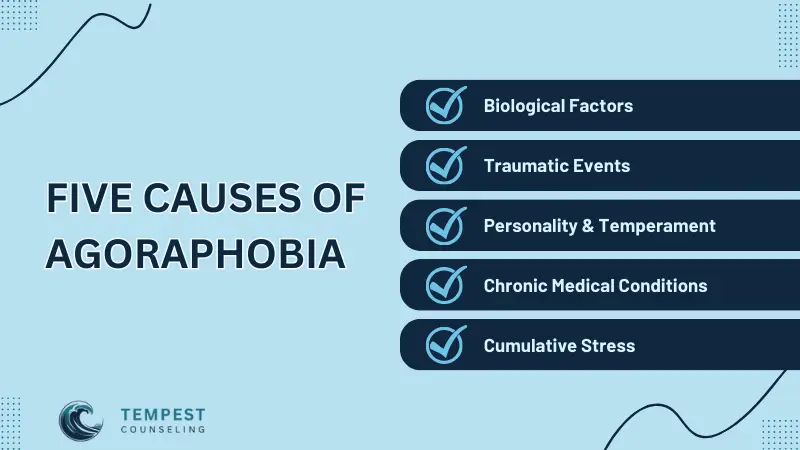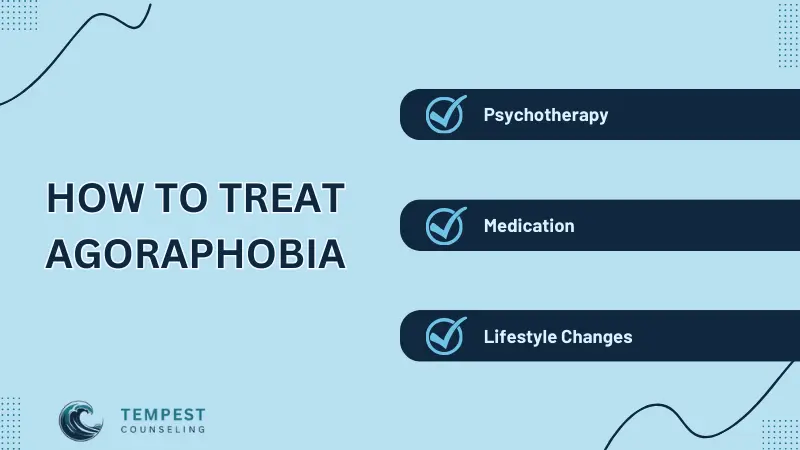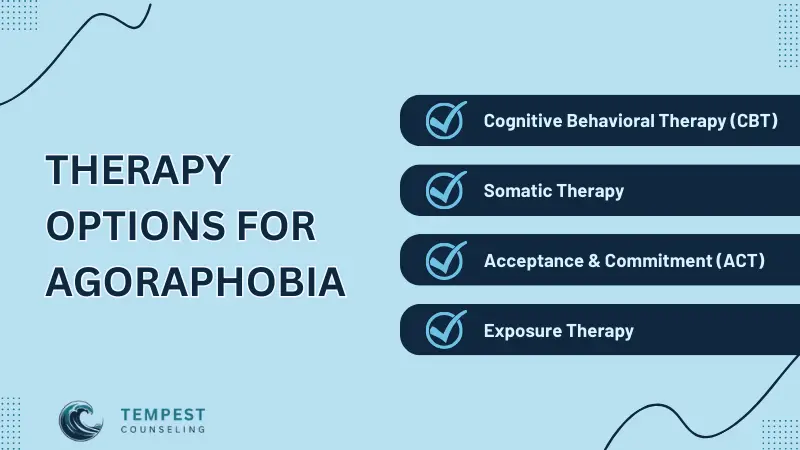Agoraphobia is a complex condition that goes beyond just being scared of open spaces. For some individuals who suffer from this problem, they are anxious about crowded areas or even venturing outside alone.
This article delves into the five primary types of agoraphobia, explores their causes and available treatments, and suggests potential paths forward for those struggling with this intricate condition.
Five Types of Agoraphobia
Agoraphobia isn’t just being scared of open spaces. It has many parts that are all connected, making it a tricky fear to understand. All these fears come from feeling stuck in places or situations that are hard to get out of. But what causes these feelings can be different for everyone.
In this section, we’ll talk about the top five types of agoraphobia. This will help us understand what people with this fear go through every day.

Fear of Open Spaces
Agoraphobia is commonly known as the fear of open spaces. This fear is rooted in the overwhelming sense of vulnerability that individuals with agoraphobia experience when exposed to vast, open areas.
The vastness of open spaces can seem daunting, as if there is too much space to keep track of, leading to feelings of being exposed or trapped with no place to hide or retreat.
While open spaces may be exhilarating to some, for those with these types of agoraphobia, the sheer scale of an expansive area can induce panic attacks, unease, and a desperate yearning for more confined or familiar surroundings.
Fear of Enclosed Spaces
Agoraphobia is not only the fear of open spaces, as many people believe. It is also associated with a significant fear of enclosed spaces, which is closely related to claustrophobia.
This fear is centered around the idea of being confined in small or restricted environments without the ability to easily escape. Spaces such as elevators, subways, or even small rooms can feel suffocating and trigger panic attacks. The feeling of being trapped can be overwhelming, and those affected often struggle to find a way out.
While some people with agoraphobia may feel comfortable in open spaces, they may find it difficult to carry out daily tasks that require spending time in an enclosed environment.
Fear of Crowds
Enochlophobia, also known as a fear of crowds, is also among the types of agoraphobia people struggle with. They experience extreme anxiety in densely populated areas due to the sheer number of people, high noise levels, and unpredictability of people’s movements.
This can make them feel trapped and overwhelmed, leading to worries about being judged, feeling embarrassed, or not being able to navigate through the crowd or find an exit. As a result, they may avoid social events, concerts, or any gathering with a large number of people.
While some might find crowds exhilarating, individuals with these types of agoraphobia perceive them as a daunting and potentially threatening experience.
Fear of Leaving Home Alone
Among the most challenging types of agoraphobia is the fear of leaving home alone. This fear goes beyond simply preferring the comfort of one’s own home and instead stems from deep-seated anxiety about going outside without a trusted companion.
Even short trips or walks around the neighborhood can become overwhelming when undertaken alone.
This fear is not always related to external factors. It can also be triggered by the possibility of experiencing panic attacks, becoming ill, losing control, or facing a situation where help may be needed but no one is around.
These types of agoraphobia can severely restrict daily activities and lead to a lower quality of life.
Fear of Driving
Agoraphobia is a common condition that affects many people, and for some, the fear of driving can be particularly overwhelming. These types of agoraphobia can cause intense anxiety, especially when driving on highways or in heavy traffic.
While some people may simply not enjoy driving, those with this fear find the thought of it paralyzing. They often worry about losing control while driving, getting stuck in traffic with no way out, or experiencing a panic attack without immediate assistance.
Avoiding driving can severely limit their mobility and independence, making it difficult or even impossible to perform activities like going to work, grocery shopping, or visiting friends and family.
Agoraphobia is a complex disorder that encompasses a range of fears. These fears can vary from being afraid of open spaces to feeling trapped in enclosed settings. The fear could be triggered by the vastness of a field, the suffocating feeling of a small room, the overwhelming energy of crowded places, the vulnerability of leaving home alone, or the anxiety of driving.
Each of these types of agoraphobia presents a unique challenge for the individual suffering from it. However, it’s important to remember that agoraphobia is not a lifelong sentence. With proper understanding and appropriate therapeutic interventions, these fears can be treated effectively, providing hope to those seeking a life free from anxiety.
See More:
- The 5 Most Crippling Symptoms of Anxiety and How to Cope
- Upgrade Your Life: 12 Simple Changes for Long-Term Freedom from Anxiety and Panic Attacks
- Discover Mindfulness for Generalized Anxiety Disorder: 5 Powerful Techniques to Alleviate Panic Attacks
- Grounding Techniques for Anxiety Attacks: 3 Powerful Strategies to Regain Balance and Control
- 5 Powerful Steps to Uncover and Address the Root Causes of Anxiety
What Causes Agoraphobia
Understanding what causes agoraphobia is a crucial step in addressing the condition. Recognizing the triggers and underlying factors can lead to more targeted and effective treatment options. Here are some primary causes to consider.

Biological Factors: Our brain chemistry and functioning significantly influence how we process emotions and handle stressful situations. Studies suggest that irregularities in specific brain areas or imbalances in neurotransmitters can lead to anxiety disorders, including agoraphobia.
Traumatic Events: Traumatic incidents, whether a single event or a series of occurrences, can be the catalyst for agoraphobic symptoms. If someone has a panic attack in a particular place, they might begin to associate that environment with fear, leading to avoidance of that location in the future.
Personality and Temperament: Certain personality traits or temperaments may make individuals more susceptible to developing agoraphobia. Naturally being more nervous or anxious can predispose individuals to such anxiety disorders.
Chronic Medical Conditions: Dealing with a persistent illness, especially those affecting mobility or the respiratory system, can sometimes give rise to agoraphobia. Individuals may fear experiencing a medical episode in unfamiliar or challenging surroundings, leading them to avoid such places.
Cumulative Stress: The buildup of smaller stressful life events can also be a driving factor behind agoraphobia. Life’s various challenges, whether they’re related to relationships, work stress, or financial difficulties, can mount up, making the external world feel increasingly intimidating.
Recognizing what causes agoraphobia not only helps individuals understand their fears better but also paves the way for the therapeutic interventions discussed in the subsequent sections.
How is Agoraphobia Treated?
Dealing with agoraphobia can be difficult, but it’s a condition that can be managed and treated successfully. Since every individual’s needs are different, there is no one perfect solution for mental health disorders.
Therefore, treatment for agoraphobia often has to be personalized.
This section will discuss the different methods of treating agoraphobia, such as psychotherapy, medication, and lifestyle changes. Each of these approaches can help you lead a more fulfilling and free life.

Psychotherapy
Psychotherapy is a cornerstone in the treatment of agoraphobia. This approach to therapy involves delving deep into an individual’s fears, behaviors, and triggers to offer personalized strategies and coping mechanisms for managing and ultimately overcoming anxiety.
The Diagnostic and Statistical Manual of Mental Disorders (DSM) provides clear criteria for diagnosing agoraphobia, which psychotherapists use as a guide to determine the most effective therapeutic interventions.
Through counseling sessions, individuals can learn to identify and challenge their fears, develop skills to manage anxiety-inducing situations, and gradually confront the scenarios they fear in a controlled environment.
With consistent therapy, many individuals experience significant relief from their symptoms, regaining a sense of freedom and control over their lives.
Medication
For people with agoraphobia, medication can be a helpful part of their treatment plan.
While psychotherapy targets the underlying fears and behaviors, anti-anxiety medication can ease the immediate symptoms of anxiety and panic attacks that may come with agoraphobia.
Different types of medications such as antidepressants, selective serotonin reuptake inhibitors (SSRIs), benzodiazepines, and even certain beta-blockers have been effective in treating this disorder’s symptoms. However, it’s important to note that the best medication and dosage may vary from person to person.
Individuals must work closely with a psychiatrist or healthcare providers to find the most suitable option with potential side effects and interactions in mind.
Regular monitoring ensures that the medication provides the desired relief without causing any unnecessary side effects, enabling individuals to fully engage in other aspects of treatment like therapy.
Lifestyle Changes
For individuals struggling with agoraphobia, adopting positive lifestyle changes can significantly enhance the effectiveness of formal treatments.
One such important change is practicing deep breathing exercises. By focusing on one’s breathing, a person can divert their attention from the overwhelming sensations of a panic attack, promoting a calming effect. These exercises help in grounding an individual, providing a method to counter the intense emotions that agoraphobia can trigger.
Exercise, especially cardiovascular workouts, holds notable therapeutic value for those with agoraphobia. Regular aerobic activities such as jogging, cycling, or swimming have been proven to release neurotransmitters like endorphins. These chemicals, often referred to as “natural antidepressants,” can boost mood, reduce stress, and alleviate symptoms of anxiety.
When the body experiences the rhythm and cadence of a cardio routine, it initiates a cascade of neural events leading to the release of these beneficial chemicals. Over time, with consistent exercise, individuals may notice a significant decrease in their general anxiety levels, providing an added defense against the onset of agoraphobic episodes.
Furthermore, incorporating these habits into one’s daily life can enable a sense of control and autonomy, which is often eroded by the debilitating fears associated with agoraphobia.
Combining these lifestyle changes with psychotherapy and medication can result in a holistic approach to treatment, addressing both the mind and body.
Psychotherapy Options for Agoraphobia
Agoraphobia is a complex condition that requires a comprehensive approach to treatment. One of the most effective methods is psychotherapy, where patients work together with trained therapists to address their fears and navigate through them.
This section delves into the various psychotherapy modalities that have shown promise in treating agoraphobia, backed by substantial scientific research. From Cognitive Behavioral Therapy’s structured strategies to the embodied experiences in Somatic Therapy, we will explore each technique’s unique methods and benefits.

Cognitive Behavioral Therapy (CBT)
Cognitive Behavioral Therapy (CBT) is one of the most effective treatments for agoraphobia.
CBT operates on the principle that our thoughts, feelings, and behaviors are interconnected, and by identifying negative thought patterns, we can change our behaviors and emotions.
For people with agoraphobia, CBT aims to identify the negative thought patterns that cause fear of certain situations or spaces. Once identified, the therapist helps the individual challenge these beliefs and replace them with more realistic perceptions.
Gradual exposure to fearful situations, often integrated within CBT, allows individuals to confront their fear and reduce it progressively, while also providing them with coping strategies to manage anxiety.
Regular sessions can lead to significant reductions in agoraphobic symptoms and a renewed sense of confidence in navigating previously intimidating situations.
Somatic Therapy
Somatic therapy is a holistic treatment approach that acknowledges the strong connection between the mind and body. It can be particularly helpful for individuals struggling with agoraphobia since it aims to address both the physical and emotional symptoms of anxiety and fear.
Unlike traditional therapies that focus solely on cognitive aspects, somatic therapy emphasizes the physiological responses of the body. This approach believes that emotional distress and trauma can manifest in our bodily tissues, leading to physical discomfort and symptoms.
By utilizing techniques such as deep breathing, guided visualization, and grounding exercises, individuals learn to become more attuned to their bodily sensations and recognize early signs of anxiety.
This helps individuals with agoraphobia to better control their physical responses to stress, allowing them to confront and navigate anxiety-provoking situations more effectively.
This body-centered approach not only helps alleviate immediate symptoms but also promotes a deeper sense of harmony and connection within oneself.
Acceptance and Commitment Therapy (ACT)
Unlike traditional methods that focus on reducing symptoms, Acceptance and Commitment Therapy (ACT) emphasizes the importance of acceptance and mindfulness strategies, in addition to commitment-based behavior change.
The central idea is to help individuals understand and accept their internal experiences, such as fear or anxiety, rather than resist or avoid them. This means that while they might still feel fear, it no longer controls their actions.
ACT helps individuals with agoraphobia develop psychological flexibility, which allows them to pursue meaningful actions despite the presence of distressing emotions.
Through this therapeutic journey, individuals with agoraphobia learn to coexist with their fears, making choices that align with their personal values and leading a fulfilling life beyond the constraints of their condition.
Exposure Therapy
Exposure Therapy is one of the most effective treatments for agoraphobia, backed by extensive evidence.
At its core, this approach gradually exposes individuals to the situations they fear in a systematic and controlled manner, without the anticipated negative outcome. The primary objective is to help individuals face and gain control over their anxiety and distress, which they may have been avoiding earlier.
This helps individuals see that their fears are often unfounded or exaggerated, which in turn reduces the avoidance behavior characteristic of agoraphobia.
By confronting the situations that previously induced fear, individuals can recalibrate their responses and realize that these situations are not as threatening as they once believed. This realization empowers them to reclaim their freedom and navigate the world with renewed confidence and resilience.
Agoraphobia is a complex condition that can have a significant impact on a person’s life. It requires a personalized therapeutic approach that takes into account the individual’s unique circumstances.
At Tempest Counseling, we understand that everyone’s situation is different, and therefore, we don’t offer a one-size-fits-all treatment plan. Instead, we combine the strengths of different therapies, including Cognitive Behavioral Therapy, Somatic Therapy, Acceptance and Commitment Therapy, and Exposure Therapy, to create a customized treatment plan for each client.
This holistic combination helps us address the root causes and symptoms of agoraphobia while empowering our clients to regain their confidence and resilience.
What is the Outlook for People with Agoraphobia?
When dealing with agoraphobia, it’s crucial to understand the journey ahead. However, the good news is that this anxiety disorder has a highly promising outlook.
With the right combination of treatment approaches and support, many individuals can experience significant improvement and even a full return to their previous levels of functioning.
Agoraphobia is among the anxiety disorders that respond exceptionally well to treatment, so with early intervention, most individuals can lead fulfilling, active lives free from the overwhelming constraints of their fears.
Thanks to advances in therapeutic techniques, medication, and growing awareness of the disorder, people today have more resources and support than ever before.
What’s Next?
If you or a loved one struggles with agoraphobia, taking the first step towards understanding and addressing it can be the beginning of a transformative journey towards reclaiming life.
You are not alone, and effective help is available. Tempest Counseling offers a compassionate and comprehensive approach, integrating the best therapeutic practices tailored to your unique needs.
To explore how we can be instrumental in your path to recovery and to gain a deeper insight into our methodology, we invite you to book a free consultation call with our specialists. Together, we can chart a course to a life free from the shackles of agoraphobia.
It’s not just about coping; it’s about thriving. Your next chapter awaits, and Tempest Counseling is here to guide you every step of the way.


